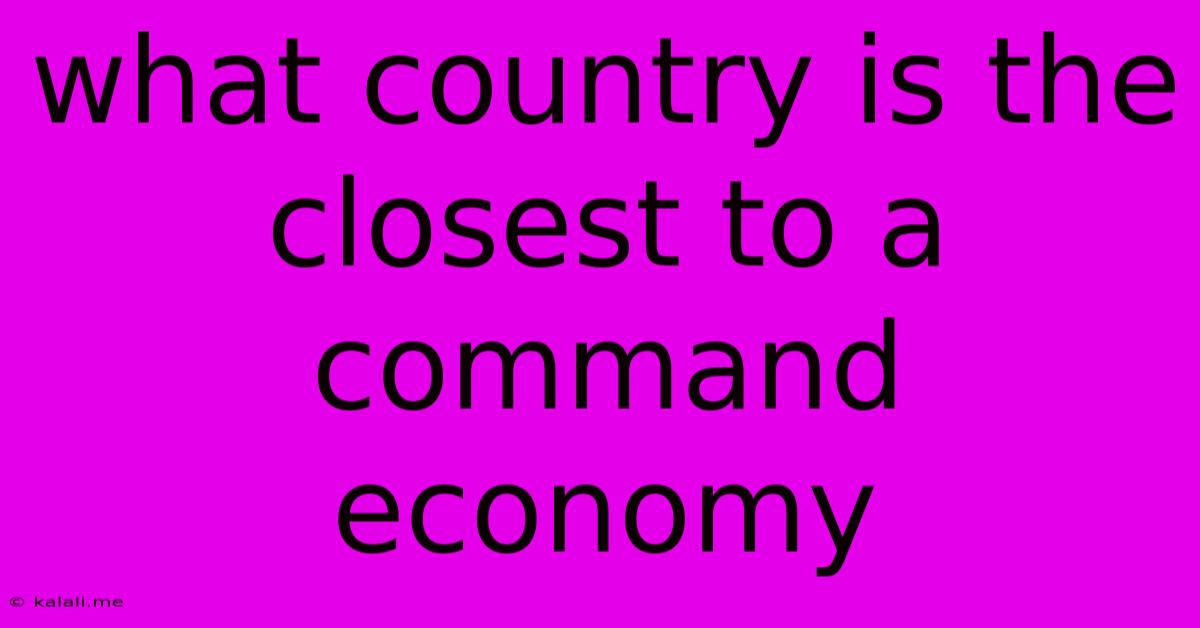What Country Is The Closest To A Command Economy
Kalali
Jun 02, 2025 · 3 min read

Table of Contents
What Country is the Closest to a Command Economy? A Look at Modern Economic Systems
The pure command economy, where the state completely controls the means of production and distribution, is largely a relic of the past. While no country perfectly embodies this model today, some nations exhibit characteristics closer to it than others. Understanding which countries exhibit these traits requires examining factors like state ownership of industry, centralized planning, and price controls. This article explores those factors and identifies the countries that most closely approximate a command economy in the modern world.
Understanding the Command Economy Model
A command economy, also known as a planned economy, is characterized by:
- Centralized Planning: The government dictates production quotas, resource allocation, and pricing. Market forces play a minimal role.
- State Ownership: The state owns and controls most, if not all, means of production, including factories, farms, and natural resources.
- Price Controls: The government sets prices for goods and services, often resulting in shortages or surpluses.
- Limited Consumer Choice: Consumer choice is restricted by what the state produces and makes available.
- Lack of Competition: Competition is largely absent due to state monopoly.
Modern Approximations: A Spectrum of Control
It's crucial to understand that even countries considered closest to a command economy operate within a nuanced spectrum. Complete control is extremely rare, and most incorporate elements of other economic models, creating mixed economies. However, some nations lean significantly towards centralized control.
Historically, the Soviet Union and its satellite states represented the closest examples of command economies. However, their collapse highlights the inherent instability and inefficiencies of such systems.
Countries Exhibiting Command Economy Characteristics:
While a pure command economy is extinct, certain nations demonstrate a stronger state presence in their economies:
-
North Korea: Often cited as the closest modern example, North Korea's economy remains highly centralized and state-controlled. The government dictates production targets, owns most industries, and severely restricts private enterprise and market mechanisms. This results in widespread shortages and economic hardship.
-
Cuba: While Cuba has undertaken some market reforms, the government still maintains significant control over key sectors of the economy and plays a dominant role in resource allocation and price setting. State-owned enterprises continue to be prevalent.
-
Venezuela: Venezuela's economy, although significantly impacted by political and economic instability, has historically seen extensive state intervention and nationalization of industries. While recent years have seen some attempts at liberalization, the government continues to exert significant influence.
-
China: While China's economy is largely market-oriented, the Communist Party retains considerable control, especially in strategic industries and through its state-owned enterprises (SOEs). While private enterprise flourishes, the state's influence is undeniable.
Important Considerations:
It's important to avoid simplistic labeling. The degree of state control fluctuates, and even within these nations, there is often regional variation. Furthermore, economic systems are dynamic and constantly evolving.
Conclusion:
No country today perfectly fits the definition of a pure command economy. North Korea comes closest, exhibiting the highest degree of state control and centralized planning. However, even in North Korea, the reality is more complex than a simple categorization. Cuba, Venezuela, and even China, to a lesser extent, show elements of centralized control, demonstrating that the remnants of this model, in various forms, continue to shape the economic landscapes of specific nations. Further research into the specific policies and economic structures of these nations will provide a more complete understanding of the complexities of their systems.
Latest Posts
Latest Posts
-
Can You Use An Xbox 360 Controller With Xbox One
Jun 03, 2025
-
How To Find The Difference In Medians
Jun 03, 2025
-
How Can I Get Rid Of Spiders In My Car
Jun 03, 2025
-
1 Update The Main Orders Page Status As Follow
Jun 03, 2025
-
How Is The Tire Size Measured
Jun 03, 2025
Related Post
Thank you for visiting our website which covers about What Country Is The Closest To A Command Economy . We hope the information provided has been useful to you. Feel free to contact us if you have any questions or need further assistance. See you next time and don't miss to bookmark.